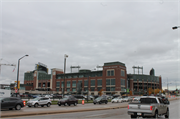| Additional Information: | Beginning in 1925, the Green Bay Packers professional football team played at City Stadium, located adjacent to East High School along North Baird Street. The stadium proved inadequate for demand by the 1950s, when Milwaukee built the Milwaukee County Stadium, in part as an effort to lure the Packers to permanently move. Other National Football League owners encouraged the Packers organization to move and in response, the City of Green Bay began work on a new City Stadium. Lambeau Field, formerly known as City Stadium, was constructed from 1956 to 1957 by the Green Packers organization for $960,000 on a site at the southwest suburban edge of Green Bay. The stadium was designed by architect John Sommerville and the general contractor was George Hougard and Sons and had a capacity of 32,500 people. For more information on Sommerville refer to Chapter 7 Architecture. The new stadium was the first of its kind built specifically for a National Football League (NFL) franchise team; However, the team continued to play several home games in Milwaukee each season. In 1961, in response to ticket demand, the stadium was expanded to accommodate a capacity of 38,669 fans. In 1965, City Stadium was renamed Lambeau field in honor of the founder, player, and long-time head coach, Curly Lambeau, who had died earlier in the year. The stadium has grown consistently since, with the capacity increased to 42,327 in 1963, 50,860 in 1966, and then 56,263 in 1970, when the bowl was fully enclosed on all sides and the seating raised.
The stadium continued to grow with time as the capacity was increased in 1985, and again in 1995, to reach 60,890 people. The appearance of Lambeau Field began to be similar to its present form at this time. However, to remain competitive with other NFL franchises and avoid the construction of a new stadium, Lambeau Filed was extensively renovated from 2001 to 2003 with a surrounding development plan, new features, a new field, amenities, and an increase in its capacity to 72,515 fans. Further renovations in 2010, intended to modernize the stadium with heated spaces, digital technology, terraces, and a new scoreboard were completed by 2013 bringing the capacity to 80,750, one of the largest stadiums in the United States. A new atrium was added in 2015. After its construction, the stadium, owned by the City of Green Bay, has hosted other events besides Green Bay Packers games including local high school sports, benefit sporting competitions, hockey games, fireworks displays, snowmobile racing, and large concerts.
In 1919, Curly Lambeau and George Calhoun organized an amateur football team in Green Bay and named it the Green Bay Packers after convincing the Indian Packing Company to donate money for uniforms and equipment. Lambeau served as the coach and played halfback for the team, which joined the newly formed American Professional Football Association in 1921, which would become the National Football Conference (NFC) a year later. The team struggled financially, and after forfeiting a season, became a publicly owned nonprofit corporation in 1923, which has remained since. Despite these setbacks, the team won three consecutive championships from 1929 to 1931 and three more in 1926, 1939, and 1944 featuring a host of football hall of fame players. Lambeau retired in 1949 and the team went into decline during the 1950s. The team's second successful period came in the 1960s following the hire of Vince Lombardi as coach in 1959 and the introduction of Bart Starr as the quarterback. Like the Packers of the 1930s, this team also featured many hall-of-fame players, winning championships in 1961, 1962, 1965, and 1966. The National Football League was formed in 1966 and the Packers proceeded to win the first two super bowls in 1967 and 1968. For more information on Bart Starr refer to Chapter 14 Notable People. The team once again went into decline after Lombardi left in 1969. The team underwent a renaissance in the 1990s, led by head coach Mike Holmgren and quarterback Brett Favre and had success, winning a super bowl. The team has also largely been successful during the twenty-first century, winning another. Lambeau Field has provided the Packers with a home-field advantage since its construction, often attributed to the active fans and climate, as the team has a significant advantage regarding its record at home for regular season and playoff games. The Packers have successfully sold out every game at Lambeau Field since 1960, the longest streak for any professional American sports team with the result that every game has also been televised since 1973. The Green Bay Packers are one of the more storied professional football teams in the game’s history, having won a total of thirteen championships, including four Super Bowls, in 1967, 1968, 1997, and 2011. All the Super Bowls during their time calling Lambeau Field home.
Robert Surplice was born in Green Bay in 1912 and attended the University of Illinois, studying architectural engineering. He married Marian Baler in 1937, and in 1938 Robert Surplice began an architectural practice in Green Bay that quickly grew into a successful firm known as Surplice Associates. The office specialized in school and commercial buildings, often embracing a modern architectural language popular in the post-war period, and primarily located across Wisconsin. Robert Surplice retired in 1974 and died in 1982. His office, Surplice Associates, typically working in a contemporary style. In 1985, Surplice Associates merged with Foth and VanDyke, an architecture and engineering firm. In 1995, the firm renamed itself Millennium Architects and Designers, Ltd. and is still operating presently. |
|---|

